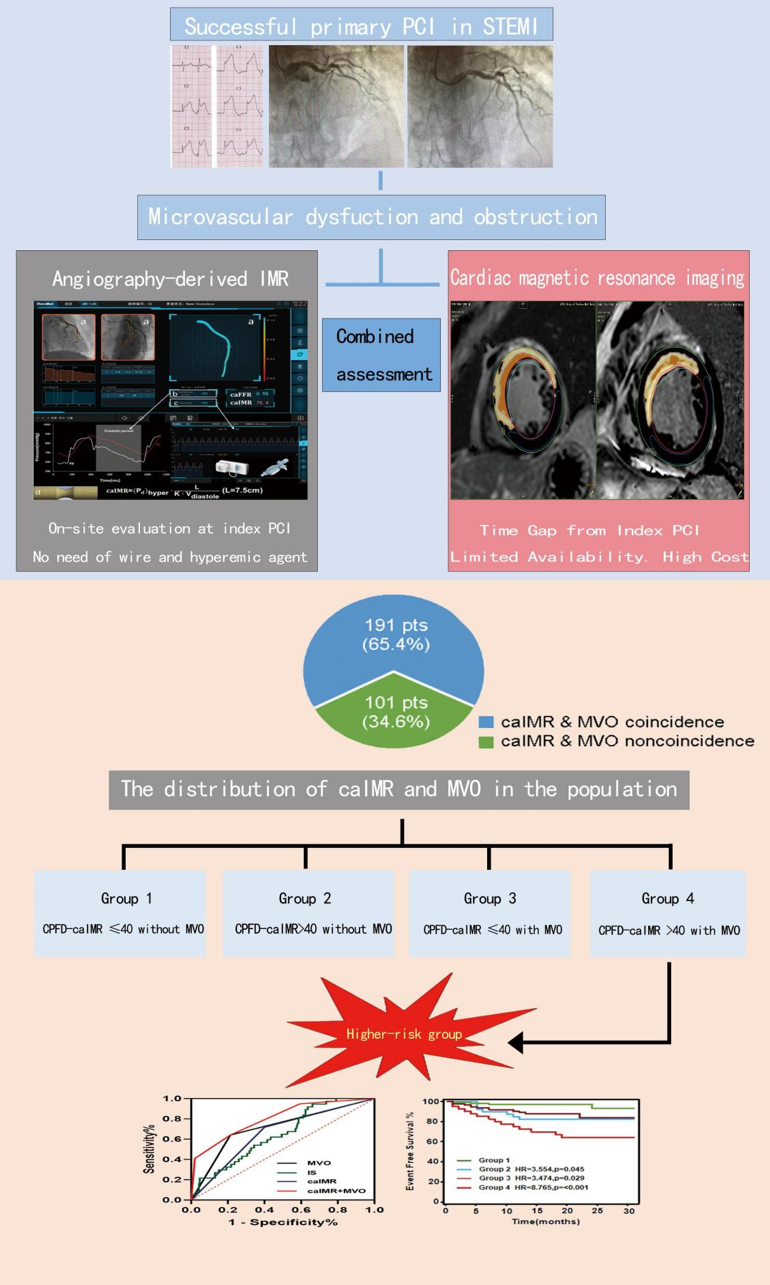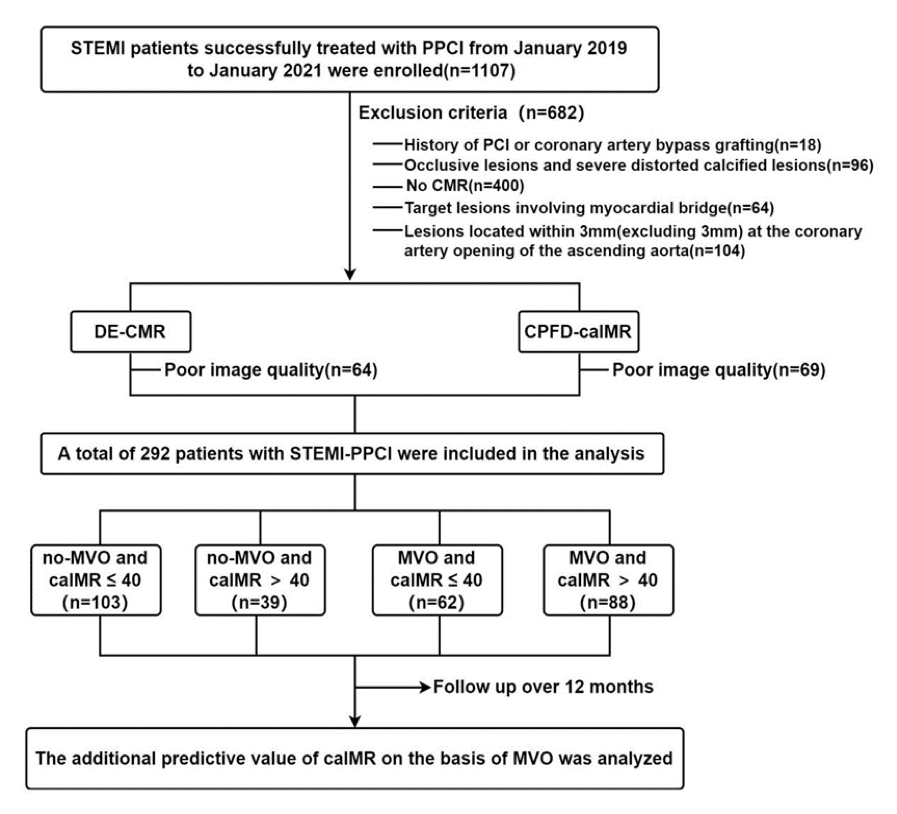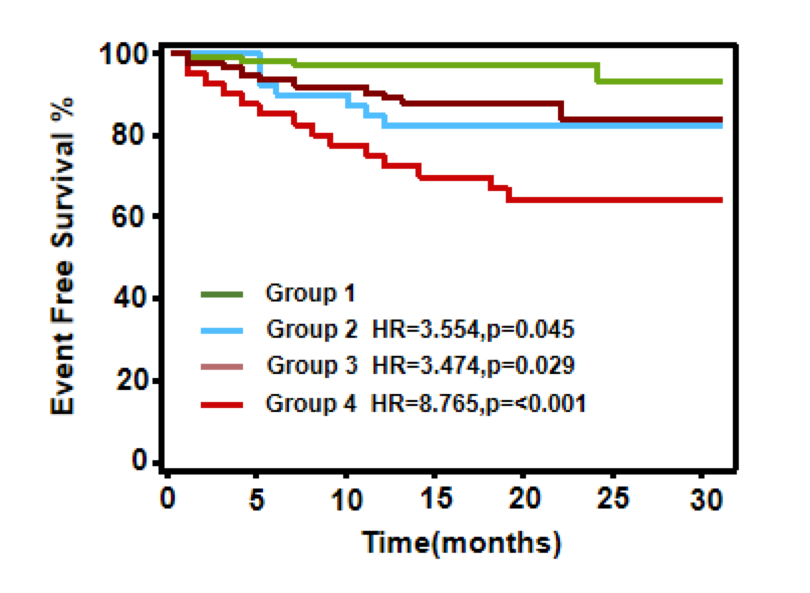Final ID: MDP544
Enhancing Prognostic Prediction in STEMI Patients: The Incremental Value of Computational Pressure-Fluid Dynamics Applied to Index of Microcirculatory Resistance
Abstract Body (Do not enter title and authors here): Background The computational pressure-fluid dynamics applied to index of microcirculatory resistance, derived from coronary angiography (CPFD-caIMR) is a promising alternative method of IMR to evaluate the prognosis of STEMI patients. This study aim to evaluate the incremental value CPFD-caIMR and MVO in predicting MACE after patients with undergoing primary percutaneous coronary PPCI.
Methods A total of 292 patients who met the inclusion criteria were selected retrospectively from 1107 STEMI patients from January 2019 to January 2021 in Affiliated Hospital of Xuzhou Medical University in China. All patients with STEMI underwent CPFD-caIMR and MVO assessment. The patients were categorized into four groups based on CPFD-caIMR and MVO presence: 1) CPFD-caIMR ≤40U without MVO; 2) CPFD-caIMR >40U without MVO; 3) CPFD-caIMR ≤40U with MVO; and 4) CPFD-caIMR >40U with MVO. The primary endpoint of the study was MACE, defined as cardiovascular or all-cause deaths, non-fatal MI, revascularization including target vessel reconstruction, heart failure readmission.
Results Within the included 292 patients, a notable proportion of 101 cases (34.6%) revealed discrepancies between CPFD-caIMR and MVO. Among these, 103 patients (35.3%) exhibited CPFD-caIMR values of ≤40 without MVO, while 88 patients (30.1%) displayed CPFD-caIMR values of >40 with MVO on CMR. Both MVO (HR: 2.750, p=0.033) and CPFD-IMR>40U (HR: 3.572, p=0.001]) were predictors of MACE over 12 months. Specifically, for every 1-unit increase in CPFD-IMR>40U, MACE increased by 3.572 units. Furthermore, ROC curve analysis demonstrated that CPFD-caIMR>40U (AUC, 0.724, p<0.001) and MVO (AUC, 0.667, p=0.001) were effective in predicting MACE. Notably, combined CPFD-caIMR and MVO increased the area under the curve for MACE to 0.820, p<0.001). Over 12 month of follow-up, Group 4 (HR: 8.765, p <0.001) but not Group 3 (HR: 3.474, p=0.029), Group 2(HR:3.554, p=0.045) had worse clinical outcomes compared with those with no significant CMD in Group 1.
Conclusion: CPFD-caIMR is a novel method for noninvasive detection of microvascular reperfusion failure, and CPFD-caIMR > 40U can predict the prognosis of STEMI patients.When combined with CMR, CPFD-caIMR > 40U can be used to further stratify the risk of STEMI and to identify high-risk patients who may require more aggressive treatment during follow-up.
Methods A total of 292 patients who met the inclusion criteria were selected retrospectively from 1107 STEMI patients from January 2019 to January 2021 in Affiliated Hospital of Xuzhou Medical University in China. All patients with STEMI underwent CPFD-caIMR and MVO assessment. The patients were categorized into four groups based on CPFD-caIMR and MVO presence: 1) CPFD-caIMR ≤40U without MVO; 2) CPFD-caIMR >40U without MVO; 3) CPFD-caIMR ≤40U with MVO; and 4) CPFD-caIMR >40U with MVO. The primary endpoint of the study was MACE, defined as cardiovascular or all-cause deaths, non-fatal MI, revascularization including target vessel reconstruction, heart failure readmission.
Results Within the included 292 patients, a notable proportion of 101 cases (34.6%) revealed discrepancies between CPFD-caIMR and MVO. Among these, 103 patients (35.3%) exhibited CPFD-caIMR values of ≤40 without MVO, while 88 patients (30.1%) displayed CPFD-caIMR values of >40 with MVO on CMR. Both MVO (HR: 2.750, p=0.033) and CPFD-IMR>40U (HR: 3.572, p=0.001]) were predictors of MACE over 12 months. Specifically, for every 1-unit increase in CPFD-IMR>40U, MACE increased by 3.572 units. Furthermore, ROC curve analysis demonstrated that CPFD-caIMR>40U (AUC, 0.724, p<0.001) and MVO (AUC, 0.667, p=0.001) were effective in predicting MACE. Notably, combined CPFD-caIMR and MVO increased the area under the curve for MACE to 0.820, p<0.001). Over 12 month of follow-up, Group 4 (HR: 8.765, p <0.001) but not Group 3 (HR: 3.474, p=0.029), Group 2(HR:3.554, p=0.045) had worse clinical outcomes compared with those with no significant CMD in Group 1.
Conclusion: CPFD-caIMR is a novel method for noninvasive detection of microvascular reperfusion failure, and CPFD-caIMR > 40U can predict the prognosis of STEMI patients.When combined with CMR, CPFD-caIMR > 40U can be used to further stratify the risk of STEMI and to identify high-risk patients who may require more aggressive treatment during follow-up.
More abstracts on this topic:
Clinical Characteristics of Five Different Endotypes from Coronary Reactivity Testing, and the Emergence of Sex Patterns in Coronary Microvascular Dysfunction
Namkoong Jenny, Mccarthy Mary, Toleva Olga, Nield Lynne, Rinfret Stephane, Miner Steven
Angiography-based pulmonary capillary transit time is a promising diagnostic tool for single ventricle pulmonary arteriovenous malformationsBergstrand David, Spearman Andrew



